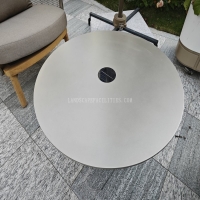Welcome to the website for landscape facilities products and knowledge.
What are the noise levels like when placing objects or moving chairs around the table?
When considering the acoustic environment of a living or working space, the noise generated by placing objects on tables or moving chairs deserves significant attention. These everyday activities can produce sound levels ranging from 40 to 75 decibels, depending on multiple factors including furniture design, flooring materials, and movement techniques.
The science behind these noises reveals fascinating physics. Chair movement creates sound through multiple mechanisms: legs scraping against flooring surfaces generate friction noise, while the impact of chair legs contacting the ground produces sudden acoustic energy. Similarly, placing objects on tables creates noise through vibrational energy transfer - when items make contact with table surfaces, the impact creates vibrations that travel through the material and radiate as audible sound waves.
Several key factors dramatically influence these noise levels. Flooring material stands as the primary determinant - hardwood floors tend to amplify scraping sounds, reaching up to 70 decibels, while carpeted surfaces can reduce this by 50-60%. Chair design equally matters; chairs with rubberized leg caps or felt pads can decrease noise output by approximately 15 decibels compared to bare metal or plastic legs. The table construction itself contributes significantly - solid wood tables tend to produce deeper, more resonant sounds when objects contact them, while tables with sound-absorbing underlayers can dampen impact noises effectively.
Movement technique also plays a crucial role in noise generation. Lifting chairs completely when repositioning them can reduce noise levels to approximately 45 decibels, while dragging creates significantly higher acoustic disturbance. The weight and material of objects being placed on tables equally influence the resulting sounds - lightweight ceramic cups might create 55-decibel impacts, while heavier metallic objects can reach 65 decibels or more.
Modern furniture technology offers innovative solutions for noise reduction. Advanced polymer composites in chair construction can absorb vibrational energy before it becomes audible sound. Table surfaces incorporating micro-textured finishes help minimize the acoustic impact of object placement. For existing furniture, simple modifications like adhesive felt pads, rubber caps, or specialized floor protectors can achieve substantial noise reduction of 10-20 decibels.
Understanding these acoustic principles enables more informed decisions when selecting furniture or arranging spaces where noise sensitivity matters. Whether designing a quiet office environment, creating a peaceful home dining area, or planning a noise-controlled recording space, recognizing how furniture interaction generates sound provides valuable insights for achieving optimal acoustic comfort.
Related search:

Recommendation
Outdoor stainless steel table with solar-powered ambient lighting feature - excellent design.